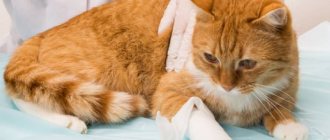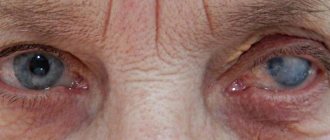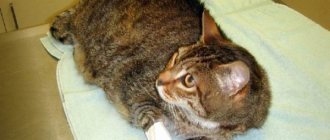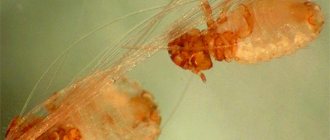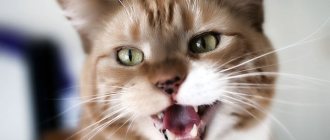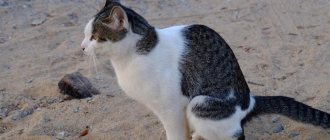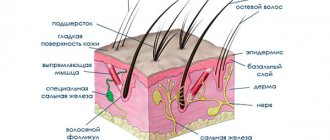It is not without reason that loving owners call their pets “tailed”: this part of the body is truly prominent in every cat and allows your pet to demonstrate an incredible range of emotions. Any breeder knows that tail twitching is not a good sign, indicating that your cat is not in a good mood. But this part of the body is much more important and is not just a “mood barometer”, as many people think. Moreover, a “sick” tail in cats is not such a harmless phenomenon. Any injuries or other pathologies are fraught with serious health problems.
What is a tail even for? As we have already noted, it is needed not only so that the cat can express its emotions. Firstly, everyone knows about the incredible grace and dexterity of all cats. This is largely due to the tail: it plays the role of a balancer and rudder, helping the animal maintain balance in any conditions. Cats that have lost their tail evoke involuntary pity: they cannot run along the fence with the same dexterity, and even when simply running, their “loin” gets carried away a lot.
What are the dangers of tail injuries and diseases?
Often, “experienced” breeders believe that a tail injury is not at all a reason to contact a veterinarian. Like, “it will heal just like that”, “it does not pose a danger to the health of the animal.” Of course, in the case of minor injuries, this is partly true, but still leaving such pathologies without attention is not the best idea.
Some amateurs will agree with this: supposedly inside the caudal vertebrae there is... a spinal cord, damage to which is fraught with extremely serious consequences. Fortunately, there is no spinal cord there . Otherwise, how would cats live if, for one reason or another, they lost this part of their body?!
But still, the erroneous point of view, no matter how strange it may seem, has a rational grain. Yes, there are no vital areas of the central nervous system in the tail, but at the same time, the caudal vertebrae are directly connected to the sacral region, which actually contains the spinal cord... Simply put, if festering wounds in the tail are not treated, the consequences can be very diverse, up to complete or partial paralysis of your pet’s body. You shouldn’t joke with these pathologies, and you shouldn’t take them seriously either.
Prevention
In order not to guess why a cat has a bump on its tail or any other formations, it is best not to let the animal go outside unnecessarily, especially in the spring. If this is not possible, and the pet still goes for walks periodically, then in this case it is recommended to purchase a special collar, the smell of which will drive away parasites.
To exclude most other problems, you need to review the animal’s diet and balance it so that the cat receives all the necessary mineral components and vitamins. However, allowing obesity is also not recommended.
Sometimes bumps of this type are congenital. They become noticeable immediately after the kitten is born. In this case, the defect does not affect the condition of the animal in any way, so there is no cause for concern. But it’s better to play it safe and rule out other pathologies.
Mechanical injuries
One of the most common groups of pathologies. Most often, something wrong happens to the tails of cats that regularly walk outside. It happens that pets get their tail pinched by a door, in other cases they lose it in fights with other cats or as a result of dog attacks. It happens that cyclists or children run across a tail carelessly laid out on the road... In short, there are a lot of causes of mechanical injuries.
It is easy to notice them: the tail becomes “flaccid”; the cat cannot (and does not want, since it is in great pain) to move it. Please note that not all cases show visual signs of crushing or fracture. At first glance, the organ may appear intact.
The clinical picture is quite specific and easily noticeable:
- When trying to take a cat's tail, its owner reacts extremely nervously and even aggressively.
- The organ can be bent at a completely unimaginable angle to the horizon.
- In the most severe cases, when the injury was really serious, not limited to the tail, urinary/fecal incontinence may occur. This is a very bad sign, indicating either some kind of infection (in advanced cases), or damage to the sacral spine.
Diagnosis and treatment
The specialist will carefully examine your pet's tail and also conduct a series of neurological tests. The latter make it possible to understand whether the animal’s nervous system is damaged. In particular, if the cat has no tail sensation at all, treatment options will be limited.
The following types of diagnostic tests are recommended:
- Complete blood test, including checking its biochemical status.
- Analysis of urine.
- It is necessary to perform radiographs of the sacral and caudal spine. Often, after taking a photo, it becomes clear what exactly happened to the pet.
Treatment, as we said above, depends on the underlying cause identified by a veterinarian.
- In cases where the injury is not serious (mild bruise), simple rest will help.
- In more severe cases, it is often necessary to resort to amputation of the affected part of the body.
Note that when the tail is dislocated, it is often possible to confine itself to its reduction: other medical care (as a rule) is no longer required after this. Even with wounds, it rarely comes to surgery. If, of course, the owners at least somehow provided assistance to their pet.
Features of wound treatment
In case of serious wounds to the tail, accompanied by severe and profuse bleeding, we would advise not to engage in “amateur activities”, but to immediately show the cat to a veterinarian.
A specialist will be able to immediately determine the severity of the injury. Secondly, it is necessary to immediately cut the affected area of the body so that the wound is clearly visible and can be properly cared for.
We strongly recommend using scissors with rounded ends for this purpose. This will prevent additional injury to the skin. After freeing the edges of the wound and some of the skin nearby, clean off blood and other debris using a cotton pad soaked in sterile saline solution. After this, you can lubricate the edges (but not the wound itself!) of the wound canal with alcohol tincture of iodine.
Take a good look inside. If bones or bone fragments are clearly visible in the thickness of the wound, further independent treatment is not advisable: we advise you to contact a veterinarian as soon as possible.
In cases where the injury is not so serious, you can try to cope with the problem yourself. Light abrasions and wounds can simply be covered with a bandage, but not everything is so simple: most likely, your cat’s tail was not injured in the operating room, and therefore the wound canal is inevitably contaminated with microflora. Simply put, the tail will quickly become inflamed.
To avoid this, it is necessary to use Vishnevsky’s balsamic liniment, or synthomycin liniment. Ichthyol ointment has also proven itself well. These are very simple, cheap, but still extremely effective remedies.
They are also easy to use. First, soak a gauze pad with the ointment, and then apply it over the wound (previously cleaned of hair and other contaminants). To prevent the napkin from rolling off, it is fixed by making a tight bandage.
And this is where problems can arise: if you simply put a bandage on the tail, the bandage will soon fly out of its place, and therefore there will be no use from it. To prevent this from happening, you need to start bandaging from the tip of the tail (more precisely, closer to it), lifting the bandage upward in a spiral, towards the root of the tail.
Another problem is cats' tendency to rip off any bandages. If the cat constantly frees its tail from the bandage, it will take a very long time to treat it, and without any special guarantees of success. When your pet is particularly active and impatient, we highly recommend that you immediately consult a veterinarian and place a surgical collar on the animal's neck.
If for some reason this is not possible, you can lubricate the outside of the bandages with something bitter and very unpleasant to the taste. For example, pure ichthyol (which, among other things, has a pronounced anti-inflammatory effect) is suitable.
When to resort to radical methods of treatment?
If your cat cannot feel its tail (that is, does not react in any way to its pin pricks) and has urinary and fecal incontinence, there is no point in engaging in “self-medication”.
All these signs indicate a truly serious injury, which resulted in damage to the sacral spine and spinal cord.
In addition, this happens in advanced cases of tail injuries, when the infection in the blood vessels of the organ begins to spread higher. In such situations, it is recommended to urgently remove the affected body part surgically. Of course, a tailless cat will lose some of its agility and grace, but will remain alive.
Serious injuries to a cat's tail can cause the cat to experience (sometimes lifelong) problems with urination and defecation. It is necessary to prescribe diuretics and stool softeners (as well as laxatives). When things get really bad, it comes down to indwelling urinary catheters.
Cauda equina syndrome
In general, this pathology can be partly considered a type of severe trauma, since sometimes its symptoms develop against their background. But not always. So, what is a ponytail? This is the name for a set of various disorders (i.e., a syndrome) that lead to a “sagging” tail in a cat. The organ often takes the form of a rope attached to the cat. In addition, the pathology in many cases is accompanied by complete or partial paralysis of the rear part of the cat’s body.
What are the reasons for the development of such a severe pathology? They are also very serious: starting from the same injuries of the sacral region, which led to damage to the spinal cord, ending with oncology and autoimmune diseases.
Accordingly, the appearance of a ponytail in a cat is a reason for an urgent visit to the veterinarian. Delay can be fatal.
Ligament rupture
In cats, ligament rupture is possible. They are dense, fibrous tissue that envelops the joints. Ligaments are more likely to tear in a cat's limbs, but the problem can occur in the spine and tail.
This can happen due to injury or birth defects. A torn ligament causes severe pain in the tail.
The diagnosis can be confirmed using an x-ray. Treatment can last about a year. You will need to wear a special fixation bandage.
Seborrhea (dry and oily)
If your pet suddenly starts smelling like a dog, so much so that it becomes difficult to be in the same room with the cat, do not rush to accuse him of being unclean. It is possible that your pet suffers from seborrhea. This is a disease characterized by impaired sebum secretion. If too much of it is secreted, then seborrhea is, accordingly, called “oily.” With insufficient secretion of sebum, a dry type of the disease develops.
Veterinarians are still arguing about the causes of the disease , but to this day many cases must be considered idiopathic, since not a single study has helped to identify a single predisposing factor. In cats, the most common is the “fat” variety.
The clinical picture is quite characteristic . In addition to the unpleasant odor already mentioned above, numerous dandruff appears on the animal’s skin and fur (with the dry variety), or the cat’s tail resembles an unsightly icicle. In the latter case, this happens because the sebum released in incredible volumes simply sticks the hair together.
Please keep in mind that this disease, once it appears, is sure to recur later. As a rule, it takes a lifetime to treat.
The intervals between relapses (with proper feeding and good living conditions) can reach several months.
The main predisposing factors are:
- Temperature changes, as well as keeping the cat in rooms with excessively dry air (which is typical for all apartments with central heating).
- It is believed that one of the main reasons for the development of seborrhea in many cases is a variety of allergic reactions.
- The same can be said about diseases of fungal etiology. Pathogenic fungi and yeast have a very bad effect on the condition of the skin.
- “Raw” or “oily” seborrhea is a common consequence of severe hormonal disorders. In particular, it often appears with problems with the thyroid gland.
- Obesity. Firstly, in cats it can also be a consequence of problems with the endocrine glands. Secondly, a “swollen” cat is simply physically unable to take proper care of itself, which makes it much easier for pathogenic fungi to invade its skin. In addition, in such cases, the animal may not have seborrhea, and greasy skin is only a sign of its extreme neglect.
- Diseases of the gastrointestinal tract. If the body does not receive the proper amount of nutrients, micro- and macroelements, the likelihood of developing any diseases becomes many times higher.
- Skin diseases of tick-borne etiology. As a rule, the activity of these parasites leads to the development of a dry type of the disease: mites, gnawing through the outer layers of the skin and actively developing in them, interfere with the normal functioning of the body.
Symptoms and treatment
The symptoms are quite specific, and therefore, as a rule, there are no particular difficulties in identifying the disease. First of all, it is the tail that is affected, which as a result either becomes covered with dandruff, or takes on the appearance of a “greasy icicle.” Abundant dandruff rashes can be found in places where the animal likes to rest; they also become heavily greasy in the case of the oily type of pathology.
Another characteristic sign is very specific, sharp and extremely unpleasant. Experienced owners or veterinarians are able to make a diagnosis as soon as they smell this “aroma.” Note that seborrhea itself does not produce any odor - it is a consequence of the activity of secondary microflora.
As for treatment, it is primarily aimed at eliminating the identified root cause of the disease. Idiopathic seborrhea is treated with special shampoos, which can be purchased at any large pet store. We would recommend consulting with your veterinarian first. It is better when the shampoo is selected by an experienced specialist.
The following products have proven themselves to be effective:
- "Tea tree". It degreases the skin well and has a pronounced anti-inflammatory effect.
- Additionally, any antiparasitic shampoo. It is used in cases where the disease is caused by the activity of fleas, ticks, or other ectoparasites.
- Accordingly, when the disease is fungal in nature, shampoos with an antifungal effect are used.
Diarrhea
In some cases, stress associated with major changes in a kitten's life contributes to the development of diarrhea. Being separated from their mother and littermates, moving to a new home, and meeting new people are all stressful for kittens.
Additionally, changing your diet may cause diarrhea.
When diarrhea is caused by these types of factors, it is usually short-lived and responds to symptomatic treatment (return to previous diet, stress management, and probiotic supplements).
However, diarrhea can also be a sign of a serious illness in kittens - intestinal parasites, bacterial and viral infections, immune disorders and more.
